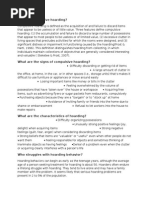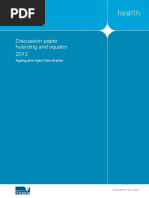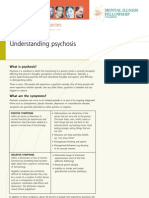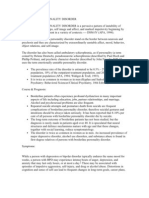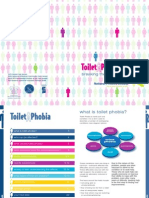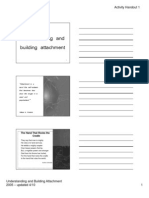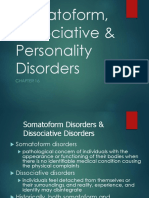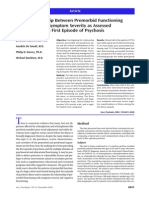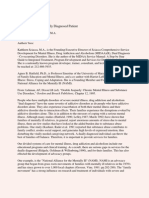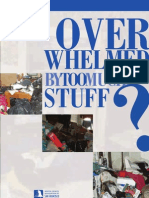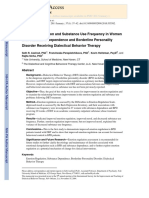Hoarding Disorder
Hoarding Disorder
Uploaded by
mavslastimozaCopyright:
Available Formats
Hoarding Disorder
Hoarding Disorder
Uploaded by
mavslastimozaOriginal Description:
Copyright
Available Formats
Share this document
Did you find this document useful?
Is this content inappropriate?
Copyright:
Available Formats
Hoarding Disorder
Hoarding Disorder
Uploaded by
mavslastimozaCopyright:
Available Formats
1.
According to the latest version of the Diagnostic and Statistical Manual of Mental Disorders
(DSM-5), hoarding disorder is described as a pattern of compulsive behaviour involving
accumulating numerous possessions that are often of little value to anyone else. While we all
have possessions that we really don't need (hence the popularity of garage sales),
compulsive hoarders take the problem to extremes that can even endanger their lives.
2. The actual cause of hoarding disorder is unknown.
a. Unique Brain Patterns
One study
3
conducted in 2008 examined brain scans of compulsive hoarders and
discovered abnormal activity in the part known as the 'bilateral anterior ventromedial
prefrontal cortex' (BAVPC), or in layman's terms, a part at the back of the brain
associated with decision making. This part is unique to mammals and is thought to
be the most advanced part of the human brain. There have been several instances
where brain damage (from strokes, infections, injuries etc.) has resulted in a patient
developing compulsive hoarding habits. Interestingly, researchers found that these
patients had impairments in the BAVPC, the same part of the brain thought to be
responsible for compulsive hoarding in non-lesion patients, suggesting that this area
plays a key role in compulsive hoarding
b. Hereditary
c. Psycho-sexual development
Sigmund Freud (1856-1939), the father of psychoanalysis, believed that compulsive
hoarding was linked with the 'anal' stage of child development. The 'anal' stage
defines the period where very young children learn how to control their bowels and
bladder through toilet training. He argued that positive and negative experiences
during this stage would go on to determine an individual's future relationship with
material objects. For instance:
i. Strict toilet training (such as being punished by parents for wetting the bed) tends to
create an 'anal-retentive personality', where a person becomes obsessively tidy,
organised and rigid throughout adult life.
ii. Lax toilet training tends to create an 'anal-expulsive personality', where a person
becomes wasteful, messy and destructive.
3. What are the signs of compulsive hoarding?
a. Difficulty getting rid of items
b. A large amount of clutter in the office, at home, in the car, or in other spaces (i.e.
storage units) that makes it difficult to use furniture or appliances or move around
easily
c. Losing important items like money or bills in the clutter
d. Feeling overwhelmed by the volume of possessions that have taken over the house
or workspace
e. Being unable to stop taking free items, such as advertising flyers or sugar packets
from restaurants
f. Buying things because they are a bargain or to stock up
g. Not inviting family or friends into the home due to shame or embarrassment
h. Refusing to let people into the home to make repairs
4. Bodies have been found in their home, virtually buried under tons of newspapers, garbage
and others. Most often, people hoard common possessions, such as paper (e.g., mail,
newspapers), books, clothing and containers (e.g., boxes, paper and plastic bags). Some
people hoard garbage or rotten food. More rarely, people hoard animals or human waste
products. Often the items collected are valuable but far in excess of what can reasonably be
used.
5. Hoarding behaviors can begin as early as the teenage years, although the average age of a
person seeking treatment for hoarding is about 50. Hoarders often endure a lifelong struggle
with hoarding. They tend to live alone and may have a family member with the problem.
6. Severe clutter threatens the health and safety of those living in or near the home, causing
health problems, structural damage, fire, and even death.
Expensive and emotionally devastating evictions or other court actions can lead to
hospitalizations or homelessness .
Conflict with family members and friends who are frustrated and concerned about the state
of the home and the hoarding behaviors
7. Compulsive hoarding can be treated. Unfortunately it has not responded well to the usual
treatments that work for OCD. Strategies to treat hoarding include:
a. Challenging the hoarders thoughts and beliefs about the need to keep items and
about collecting new things
b. Going out without buying or picking up new items
c. Getting rid of and recycling clutter. First, by practicing the removal of clutter with the
help of a clinician or coach and then independently removing clutter
d. Finding and joining a support group or teaming up with a coach to sort and reduce
clutter
e. Understanding that relapses can occur
f. Developing a plan to prevent future clutter
8. Hoarding is often a symptom of hidden mental health problems, including depression, stress,
anger or anxiety. In this case, counselling can encourage awareness and exploration in a
safe and non-judgemental space with clear boundaries.
9.
You might also like
- LSP 16Document3 pagesLSP 16Ching OBNo ratings yet
- Sample Checklist Biopsychosocial FormDocument4 pagesSample Checklist Biopsychosocial Formapi-258063603No ratings yet
- "What To Do With All That Stuff": Best Practices For Clutter and HoardingDocument28 pages"What To Do With All That Stuff": Best Practices For Clutter and HoardingState Senator Liz Krueger100% (5)
- Psychiatry Under the Influence: Institutional Corruption, Social Injury, and Prescriptions for ReformFrom EverandPsychiatry Under the Influence: Institutional Corruption, Social Injury, and Prescriptions for ReformRating: 2 out of 5 stars2/5 (1)
- Best Practices For Clutter and HoardingDocument28 pagesBest Practices For Clutter and HoardingState Senator Liz Krueger75% (4)
- Fear of Being AloneDocument28 pagesFear of Being AloneHà Anh Lê VũNo ratings yet
- Hoarding Fact SheetDocument4 pagesHoarding Fact Sheetapi-300742792No ratings yet
- Compulsive Hoarding: Understanding & Treating Compulsive HoardingFrom EverandCompulsive Hoarding: Understanding & Treating Compulsive HoardingNo ratings yet
- Hoarding Concept MapDocument5 pagesHoarding Concept Mapjessie monroe100% (1)
- Steketee Master-ClinicianDocument101 pagesSteketee Master-Clinicianrgr4321100% (2)
- Hoarding SqualorDocument131 pagesHoarding SqualorBunbury eNo ratings yet
- OCD Skin Picking Disorder Fact SheetDocument2 pagesOCD Skin Picking Disorder Fact SheetboobusNo ratings yet
- Hoarding BestPracticeGuideDocument45 pagesHoarding BestPracticeGuideTheresa SuleNo ratings yet
- Understanding PsychosisDocument8 pagesUnderstanding Psychosisc100% (2)
- Assessment Questionnaire GuideDocument7 pagesAssessment Questionnaire GuideKasandra Dawn Beriso100% (1)
- Hallmarks of A NarcissistsDocument2 pagesHallmarks of A NarcissistsMarshall W Thompson, SrNo ratings yet
- 12 Personality Disorders PDFDocument22 pages12 Personality Disorders PDFRenea Joy ArruejoNo ratings yet
- Loss, Grief, and Death Typed NotesDocument7 pagesLoss, Grief, and Death Typed NotesYoung LexieNo ratings yet
- Hoarding Disorder: A Practical Guide to an Interdisciplinary TreatmentFrom EverandHoarding Disorder: A Practical Guide to an Interdisciplinary TreatmentNo ratings yet
- Hoarding Disorder & Hair - Pulling Disorder (Trichotillomania)Document36 pagesHoarding Disorder & Hair - Pulling Disorder (Trichotillomania)Kushal KumarNo ratings yet
- Is Hoarding An Addiction ?Document9 pagesIs Hoarding An Addiction ?Ar. An.0% (1)
- Borderline Personality Disorder Write Up 2Document8 pagesBorderline Personality Disorder Write Up 2Sreejita GhoshNo ratings yet
- Anti Depressant Skills PDFDocument72 pagesAnti Depressant Skills PDFkajini2No ratings yet
- Mental Status Examination: Janine Renzel Mae B. Eusebio Bs Psychology 3-1 Clinical PsychologyDocument4 pagesMental Status Examination: Janine Renzel Mae B. Eusebio Bs Psychology 3-1 Clinical PsychologyRenzel BanielNo ratings yet
- Psychology of Compulsive Hoarding - DR Christopher MoganDocument36 pagesPsychology of Compulsive Hoarding - DR Christopher MoganDenisseGonzález100% (2)
- The Psychiatric ER Survival GuideDocument32 pagesThe Psychiatric ER Survival Guidemonkey85222No ratings yet
- HOARDING 101 BerzDocument62 pagesHOARDING 101 BerzWawan Setiawan100% (2)
- TP BookletDocument12 pagesTP BookletAkino InuiNo ratings yet
- Psychological DisordersDocument48 pagesPsychological DisordersBrian WuNo ratings yet
- Defense Mechanisms DefinedDocument4 pagesDefense Mechanisms DefinedkatrinasdNo ratings yet
- Name: - DateDocument2 pagesName: - DateGloria Escalicas BanteNo ratings yet
- Attachment HandoutsDocument51 pagesAttachment Handoutspreeti17693No ratings yet
- Unburdened: Liberating Your True Self from Emotionally Immature ParentsFrom EverandUnburdened: Liberating Your True Self from Emotionally Immature ParentsNo ratings yet
- Histrionic Personality Disorder: Effects of HPDDocument2 pagesHistrionic Personality Disorder: Effects of HPDJrBong Semanero100% (1)
- (PSYCH3) 5.4 The Person With Chronic Mental IllnessDocument3 pages(PSYCH3) 5.4 The Person With Chronic Mental IllnessDrina PaglinawanNo ratings yet
- Obsessive-Compulsive and Related DisordersDocument17 pagesObsessive-Compulsive and Related Disordersreena100% (1)
- Disorders RushedDocument40 pagesDisorders Rushedapi-391411195No ratings yet
- C P C P: Ontrolling Eople Ontrolling EopleDocument7 pagesC P C P: Ontrolling Eople Ontrolling EopleclitNo ratings yet
- Dissociative Disorder, Somatic Symptoms and Related DisorderDocument49 pagesDissociative Disorder, Somatic Symptoms and Related DisorderAlliyah PimentelNo ratings yet
- OCD Action Book List Obsessive Compulsive DisorderDocument3 pagesOCD Action Book List Obsessive Compulsive DisorderrrrrrrrrrrrrrrrrrrrrrrNo ratings yet
- Obsessions: Signs and Symptoms of OCDDocument14 pagesObsessions: Signs and Symptoms of OCDvikas takNo ratings yet
- Doron, G., Derby, D., Szepsenwol, O., Nahaloni, E., & Moulding, R. (2016) - Relationship Obsessive-Compulsive Disorder. InterfDocument9 pagesDoron, G., Derby, D., Szepsenwol, O., Nahaloni, E., & Moulding, R. (2016) - Relationship Obsessive-Compulsive Disorder. Interflauramarin25No ratings yet
- Relationship Between Premorbid Functioning and Symptom Severity As Assessed at First Episode of PsychosisDocument6 pagesRelationship Between Premorbid Functioning and Symptom Severity As Assessed at First Episode of Psychosisaldrin19100% (1)
- By:Saadia SyedDocument17 pagesBy:Saadia SyedSaadia Syed100% (1)
- Are You Emotionally Intense Eggshell Therapy and CoachingDocument11 pagesAre You Emotionally Intense Eggshell Therapy and CoachingAmanda BurnsNo ratings yet
- Progress NotesDocument13 pagesProgress Notesdnarita100% (1)
- The Family and The Dually Diagnosed Patient, Kathleen SciaccaDocument14 pagesThe Family and The Dually Diagnosed Patient, Kathleen SciaccaKathleen Sciacca, MA - Sciacca Comprehensive Service Dev. Dual Diagnosis; Motivational Interviewing100% (1)
- Suicidal Ideation, Suicide Attempt and Completed SuicideDocument3 pagesSuicidal Ideation, Suicide Attempt and Completed SuicideHannah BenitezNo ratings yet
- Obsessive-Compulsive Planning DisorderDocument9 pagesObsessive-Compulsive Planning DisorderDavid A. SchmaltzNo ratings yet
- Columbia Suicide Severity Rating Scale Screen VersionDocument2 pagesColumbia Suicide Severity Rating Scale Screen VersionPaul SmithNo ratings yet
- Overwhelmed Booklet OptDocument18 pagesOverwhelmed Booklet OptMonirul IslamNo ratings yet
- PSEUDOSCIENCE in Mental Health Treatment (Special Issue of The Behavior Therapist)Document68 pagesPSEUDOSCIENCE in Mental Health Treatment (Special Issue of The Behavior Therapist)José Paz100% (1)
- Antipsychotics Risks and BenefitsDocument38 pagesAntipsychotics Risks and BenefitsElleNo ratings yet
- Sleeping Difficulties: Harrow Mental Health Information Directory FactsheetDocument4 pagesSleeping Difficulties: Harrow Mental Health Information Directory FactsheetjmaurpNo ratings yet
- APA - DSM5 - Level 2 Anxiety Adult PDFDocument3 pagesAPA - DSM5 - Level 2 Anxiety Adult PDFEris TerryNo ratings yet
- Trauma - Stressor-Related DisordersDocument44 pagesTrauma - Stressor-Related DisordersErika Louise MiChelle Cua NavasNo ratings yet
- Exposure and Response Prevention For OCDDocument11 pagesExposure and Response Prevention For OCDAlgeria1982No ratings yet
- Search and Seizure (BatasNatin Notes)Document7 pagesSearch and Seizure (BatasNatin Notes)mavslastimozaNo ratings yet
- Labor Standards NotesDocument121 pagesLabor Standards NotesmavslastimozaNo ratings yet
- Gonzales Vs CADocument11 pagesGonzales Vs CAmavslastimozaNo ratings yet
- Sison V. Anchetagr No. L-59431 25 July 1984F A C T SDocument1 pageSison V. Anchetagr No. L-59431 25 July 1984F A C T SmavslastimozaNo ratings yet
- Bellis Vs BellisDocument1 pageBellis Vs BellismavslastimozaNo ratings yet
- Arellano Vs PascualDocument5 pagesArellano Vs PascualmavslastimozaNo ratings yet
- PAL Vs CADocument2 pagesPAL Vs CAmavslastimozaNo ratings yet
- PAL Vs CA DigestDocument3 pagesPAL Vs CA DigestmavslastimozaNo ratings yet
- ARTICLE I 1973 ConstituionDocument1 pageARTICLE I 1973 ConstituionmavslastimozaNo ratings yet
- 1 Home Insurance Vs American SteamshipDocument7 pages1 Home Insurance Vs American SteamshipmavslastimozaNo ratings yet
- Other Percentage TaxesDocument11 pagesOther Percentage TaxesmavslastimozaNo ratings yet
- Mamiscal vs. AbdullahDocument3 pagesMamiscal vs. AbdullahmavslastimozaNo ratings yet
- Positive and Negative Syndrome ScaleDocument5 pagesPositive and Negative Syndrome ScaleFarkhana MmdNo ratings yet
- Selective mutism-DSM-5-233-235Document3 pagesSelective mutism-DSM-5-233-235Mella IntaniabellaNo ratings yet
- Psychiatric Disorders in PregnancyDocument65 pagesPsychiatric Disorders in PregnancyMandeep Kaur100% (1)
- MCQs Psy Exam44 First GroupDocument7 pagesMCQs Psy Exam44 First Groupsalamred100% (3)
- Psychiatry Question Bank - 65 Multiple Choice Questions On - Psychiatry in India - PDFDocument21 pagesPsychiatry Question Bank - 65 Multiple Choice Questions On - Psychiatry in India - PDFAnkit Gupta44% (9)
- Schizoaffective DisorderDocument5 pagesSchizoaffective Disordersomebody_maNo ratings yet
- Hamilton Depression Rating Scale (HDRS) : VersionsDocument3 pagesHamilton Depression Rating Scale (HDRS) : VersionsKristian Karl Bautista Kiw-isNo ratings yet
- Ava Paravati Paradigm Shift PaperDocument15 pagesAva Paravati Paradigm Shift Paperapi-607803514No ratings yet
- Black SwanDocument6 pagesBlack SwanKASHISH DAGANo ratings yet
- The Birth of The Bipolar Disorder: Historical ReviewDocument10 pagesThe Birth of The Bipolar Disorder: Historical ReviewFELIPE ABREONo ratings yet
- 2018 - Children With Autism Spectrum Disorders and Selective MutismDocument7 pages2018 - Children With Autism Spectrum Disorders and Selective MutismAlbertTieNo ratings yet
- Mood Disorders - Group 5Document45 pagesMood Disorders - Group 5Djanelle Mei San MiguelNo ratings yet
- PAS Premorbid Adjustment ScaleDocument3 pagesPAS Premorbid Adjustment ScaleSergioMSaraivaNo ratings yet
- Final Module in Human BehaviorDocument60 pagesFinal Module in Human BehaviorNarag Krizza50% (2)
- DBT Sub UseDocument10 pagesDBT Sub UseLauren McClainNo ratings yet
- PSY 3410 Autism Spectrum Disorders & Intellectual DisabilityDocument26 pagesPSY 3410 Autism Spectrum Disorders & Intellectual Disabilityncastro1319No ratings yet
- Abnormal PsychologyDocument5 pagesAbnormal PsychologyMohammad Al-HarthiNo ratings yet
- Lesson 4 DiscussionDocument9 pagesLesson 4 DiscussionCiedelle Honey Lou DimaligNo ratings yet
- Somatoform Disorders and Factitious Disorders: DSM-1V-TRDocument33 pagesSomatoform Disorders and Factitious Disorders: DSM-1V-TRNoelle Grace Ulep Baroman100% (1)
- Bleuler S Concept of SchizoDocument9 pagesBleuler S Concept of SchizoAndreea MireaNo ratings yet
- Ivientalllln S J: Oet Practice Reading Test Part ADocument8 pagesIvientalllln S J: Oet Practice Reading Test Part APrasoon PremrajNo ratings yet
- Post-Traumatic Stress DisorderDocument12 pagesPost-Traumatic Stress Disorderecbt100% (3)
- Borderline Personality Disorder, Bipolar Disorder, Depression, Attention ... Narcissistic Personality Disorder, Diferential Diagnostic, KernbergDocument23 pagesBorderline Personality Disorder, Bipolar Disorder, Depression, Attention ... Narcissistic Personality Disorder, Diferential Diagnostic, KernbergjuaromerNo ratings yet
- Anxiety PDFDocument2 pagesAnxiety PDFHussain OtlaNo ratings yet
- PAPER II Possible Exam QuestionsDocument2 pagesPAPER II Possible Exam QuestionsMarina AlexopoulouNo ratings yet
- Psychological DisordersDocument50 pagesPsychological DisordersAmirullah ZulkifliNo ratings yet
- Annotated BibliographyDocument1 pageAnnotated Bibliographyapi-410684773No ratings yet
- Girl Interrupted Moview Review Final As inDocument3 pagesGirl Interrupted Moview Review Final As inkclsolimanNo ratings yet
- Case Protocol SchizoDocument16 pagesCase Protocol SchizoFatihah AddawiahNo ratings yet
- Psychy Supplement For Regular & Foundation 2020 PDFDocument2 pagesPsychy Supplement For Regular & Foundation 2020 PDFRAM KUMARNo ratings yet






